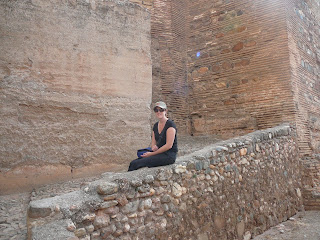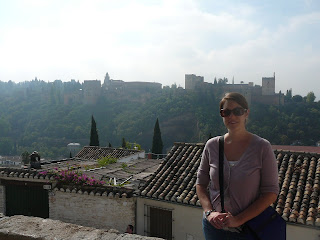 Wednesday
WednesdayOn Wednesday morning we had to get going earlier to catch our bus to Granada. One final breakfast buffet later, we set off. We caught the train across to Malaga and then caught a bus from Malaga to Granada. The bus took around two hours and we both slept most of the way.
Granada is a smaller city in the Andalucia region, situated at the foot of the Sierra Nevada mountains. The city is 738m above sea level and its population is around 240,000. It is famous for being home to the Alhambra. The Alhambra (meaning "the red one", shortened from its original name meaning "red fortress") was constructed in the 14th century as a palace and fortress complex for the Moorish rulers of Granada. The complex sits on a hilly terrace on the southeastern border of the city.
We had a bit of a mission finding our way to our hotel but we eventually got there and dropped off our gear. We had bought tickets for the Alhambra online in advance (crucial) and our time slot was 3pm. So we had a stroll through the city and got some lunch at a café on the way. We were staying near the university campus, so there were students everywhere – a contrast to Torremolinos! It reminded us a lot of our Dunedin days.
After lunch we headed up to the Plaza Nueva, where, we were reliably informed by a number of sources, there would be a minibus departing every two minutes for the Alhambra. We waited and waited and then we asked the woman in the information desk, when the next bus might be here. She told us that the minibus no longer stopped in the square and we had to go “two traffic lights and turn left”. With those extremely detailed and helpful instructions, we were not able to locate the mystery new departure point for the minibus, so we gave up and got a taxi to the Alhambra. We later discovered that if we had walked three sets of traffic lights and turned left into another square and then turned left again up a different street, then about 30 metres down that street, is the unmarked spot where the minibus leaves from. Nice.
What is not explained very well on the website is that the time on the ticket is not what time you can enter the Alhambra, but the latest time by which you must have entered the Royal Palaces, which are pretty much the main attraction within the Alhambra complex. So we arrived at the main entrance at about 2.55pm and picked up our tickets, at which point we were told that we would have to run to get to the Royal Palaces by 3.00pm, otherwise we would not be allowed entry. Fine, that’s OK, we can run, running is no problem. Then we saw a signpost just inside the entrance that read: “Royal Palaces – 20 mins walk”. Oh dear. So we pulled out our finest Usain Bolt impersonations and we managed to get to the Royal Palaces by about 3.03pm and they let us in. Phew. Not quite the leisurely and relaxed start to the afternoon we had expected, but we made it in the end! Unfortunately, this meant that we did not have time to get audio guides, which was disappointing. But we still had a fantastic time looking through the Royal Palaces.
The founder of the dynasty, Muhammed Al-Ahmar, began construction of the Alhambra as we know it today with the restoration of an old fortress, which had sat on top of the hill since the 9th century. His work was completed by his son Muhammed II, whose immediate successors continued with the repairs. The construction of the Royal Palaces dates back to the 14th century and is the work of two great kings: Yusuf I and Muhammed V. The Royal Palaces are stunning. They consist of three main chambers: the Gilded Chamber, a reception hall for the public and the administration of justice; the Chamber of Comares, official residence of the king; and the Chamber of Lions (or harem), intimate family apartments of the king. These chambers are linked by many other rooms, halls, passageways and beautiful gardens.
The Alhambra became a Christian court in 1492 when the Catholic Monarchs (Ferdinand and Isabel) conquered the city of Granada. Later, various structures were built for prominent civilians as well as military garrisons, a church and a Franciscan monastery. Emperor Charles V, who spent several months in Granada, began the construction of the palace which bears his name and made some alterations to the interior buildings.
Our tour started in the Royal Palaces and then we explored the Alcazaba, the huge fortress complete with a bell tower. We climbed up on the walls of the fortress and got amazing views down over the city of Granada. From the Alcazaba, we visited the Palace of Charles V, a huge building with a massive circular open courtyard in the centre. Our tour concluded with a leisurely walk through the beautiful "Generalife" terraced gardens that look on to the Royal Palaces.
As we were admiring the beautiful gardens, the sky got dark very quickly and we soon heard some pretty impressive thunder closing in. Luckily we had finished our tour and we were ready to leave anyway. We caught the elusive minibus from the exit of the Alhambra just as it was starting to rain. Ten minutes later, as it dropped us back in the city, it was chucking it down. We took shelter in a bookshop and then a cosy little wine bar near the Plaza Nueva, where we were given free tapas when we ordered a drink.
Once the rain eased, we continued to explore around the square and we found a street full of Moroccan-themed bars and restaurants running down the hill along the back of the square. We had a beautiful Moroccan dinner in one of the restaurants and then a lovely walk back to the hotel – once the storm had cleared it was a quite a nice, still evening.
Thursday
Thursday began with breakfast from a nearby bakery. It was a warm and sunny morning. We decided to follow a walking tour from one of our travel guide books. The route started in the Plaza Nueva and went up the hill into the Albaicin area of the city, which starts from the Plaza Nueva and goes back up the hill in the opposite direction from the Alhambra. Apart from some pretty loose directions and a rather inaccurate map in the travel guide book, which meant we had to be at our navigational best, it was a lovely walk.
There is a maze of winding cobbled streets and alleyways all over the Albaicin hill. We passed through lovely little squares hidden away from the city centre below, beautiful churches and houses and even a 16th century monastery! The midway point of the walking tour is basically at the top of the hill, where there is another square in front of the Church of St Nicholas. The square looks out across the valley to the majestic Alhambra perched on top of the other major hill in Granada. We sat there for a while enjoying the view and listening to a merry band of buskers who were entertaining a sizable crowd with their tunes. The back half of the walking tour was mainly downhill and it ended with a visit to the "El Banuelo" Arab Bath Houses, which were constructed in the 11th century. There are no baths there any more, but the original buildings are still intact, complete with star-shaped skylights in the ceilings (see photo).
We rested our legs in the Plaza Nueva briefly and then we picked up some lunch from a nearby café. Just along from where we got lunch there was a coffee shop with very familiar looking signage outside (see photo below) - obviously trademark infringement is not a big deal in Spain...
We had booked tickets on a train from Granada to Seville, which was set to leave at around 4.30pm. So we filled in the afternoon by looking at a few shops, checking out a busy marketplace and then soaking up the sun in front of the cathedral. We were keen to visit the Royal Chapel next to the cathedral, but it was closed during the afternoon – siesta time…
Our train to Seville was great – it was really new and clean and there was plenty of room. The views of the Andalucian countryside were beautiful and the three hour train journey absolutely flew by. A couple of times we passed fields full of massive black bulls (they are the symbol of Spain after all)! We arrived in Seville before 8pm.

Royal High
Court, Plaza
Nueva

Court of the
Myrtles, Royal
Palaces

Chamber
of the Lions,
Royal Palaces

Moorish
artwork
on walls

Court of
Daraxa,
Royal
Palaces

Tower of
the Ladies,
Partal

Alcazaba
fortress

View from
fortress walls -
Palace of
Charles V

Tim on
fortress
walls

Megs at
Alcazaba

View of
Granada

Palace of
Charles V

View of
Alhambra
from the
Generalife
gardens

Tim in
gardens

Ferdinand
and Isabel

Megan on
Albaicin hill

Megan in Arab
Bath Houses

Starbucks...
oh no, Starbars




1 comment:
I really miss Spain after reading this blog entry!
It made me laugh when you were having issues with catching the bus to the Alhambra - I remember mum and I had the same problem. I think we eventually found the bus stop, but it was definitely hard to find!
Totally agree that the ticket entry time is confusing.
Oh the joys of Spain!
Post a Comment